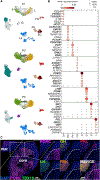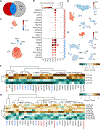Pituitary adenomas evade apoptosis via noxa deregulation in Cushing's disease
- PMID: 36001971
- PMCID: PMC9527711
- DOI: 10.1016/j.celrep.2022.111223
Pituitary adenomas evade apoptosis via noxa deregulation in Cushing's disease
Abstract
Sporadic pituitary adenomas occur in over 10% of the population. Hormone-secreting adenomas, including those causing Cushing's disease (CD), cause severe morbidity and early mortality. Mechanistic studies of CD are hindered by a lack of in vitro models and control normal human pituitary glands. Here, we surgically annotate adenomas and adjacent normal glands in 25 of 34 patients. Using single-cell RNA sequencing (RNA-seq) analysis of 27594 cells, we identify CD adenoma transcriptomic signatures compared with adjacent normal cells, with validation by bulk RNA-seq, DNA methylation, qRT-PCR, and immunohistochemistry. CD adenoma cells include a subpopulation of proliferating, terminally differentiated corticotrophs. In CD adenomas, we find recurrent promoter hypomethylation and transcriptional upregulation of PMAIP1 (encoding pro-apoptotic BH3-only bcl-2 protein noxa) but paradoxical noxa downregulation. Using primary CD adenoma cell cultures and a corticotroph-enriched mouse cell line, we find that selective proteasomal inhibition with bortezomib stabilizes noxa and induces apoptosis, indicating its utility as an anti-tumor agent.
Keywords: CP: Cancer; CP: Molecular biology; Cushing’s disease; DNA methylation; bortezomib; preclinical testing; proteasome; single-cell RNA-seq; sporadic pituitary adenoma.
Copyright © 2022 The Author(s). Published by Elsevier Inc. All rights reserved.
Conflict of interest statement
Declaration of interests The authors declare no competing interests.
Figures






Comment in
-
New mechanism of Cushing disease revealed.Nat Rev Endocrinol. 2022 Nov;18(11):657. doi: 10.1038/s41574-022-00749-5. Nat Rev Endocrinol. 2022. PMID: 36085417 No abstract available.
Similar articles
-
Aberrant Nuclear Translocation of E2F1 and Its Association in Cushing's Disease.Endocrinology. 2022 Aug 1;163(8):bqac086. doi: 10.1210/endocr/bqac086. Endocrinology. 2022. PMID: 35678423 Free PMC article.
-
Immunohistochemical properties of silent corticotroph adenoma and Cushing's disease.Pituitary. 2007;10(1):35-45. doi: 10.1007/s11102-007-0010-5. Pituitary. 2007. PMID: 17410413
-
Comparison of ACTH secretion in Cushing's adenoma and clinically silent corticotroph adenoma by cell immunoblot assay.Endocr J. 2002 Jun;49(3):285-92. doi: 10.1507/endocrj.49.285. Endocr J. 2002. PMID: 12201210
-
The Role of Glucocorticoid Receptor in the Pathophysiology of Pituitary Corticotroph Adenomas.Int J Mol Sci. 2022 Jun 9;23(12):6469. doi: 10.3390/ijms23126469. Int J Mol Sci. 2022. PMID: 35742910 Free PMC article. Review.
-
Aggressive Cushing's Disease: Molecular Pathology and Its Therapeutic Approach.Front Endocrinol (Lausanne). 2021 Jun 16;12:650791. doi: 10.3389/fendo.2021.650791. eCollection 2021. Front Endocrinol (Lausanne). 2021. PMID: 34220707 Free PMC article. Review.
Cited by
-
scRNA sequencing technology for PitNET studies.Front Endocrinol (Lausanne). 2024 Jul 24;15:1414223. doi: 10.3389/fendo.2024.1414223. eCollection 2024. Front Endocrinol (Lausanne). 2024. PMID: 39114291 Free PMC article. Review.
-
Transcriptomic Profiles of Normal Pituitary Cells and Pituitary Neuroendocrine Tumor Cells.Cancers (Basel). 2022 Dec 24;15(1):110. doi: 10.3390/cancers15010110. Cancers (Basel). 2022. PMID: 36612109 Free PMC article. Review.
-
DNA Methylation in Pituitary Adenomas: A Scoping Review.Int J Mol Sci. 2025 Jan 10;26(2):531. doi: 10.3390/ijms26020531. Int J Mol Sci. 2025. PMID: 39859246 Free PMC article.
-
PIT-1/SF-1-positive pituitary tumors in patients with acromegaly: transcriptomic perspective.Acta Neuropathol Commun. 2025 Aug 14;13(1):174. doi: 10.1186/s40478-025-02091-z. Acta Neuropathol Commun. 2025. PMID: 40813692 Free PMC article.
-
Single-cell sequencing identifies differentiation-related markers for molecular classification and recurrence prediction of PitNET.Cell Rep Med. 2023 Feb 21;4(2):100934. doi: 10.1016/j.xcrm.2023.100934. Epub 2023 Feb 7. Cell Rep Med. 2023. PMID: 36754052 Free PMC article.
References
-
- Allaerts W, Tijssen AM, Jeucken PH, Drexhage HA, and de Koning J (1994). Influence of folliculo-stellate cells on biphasic luteinizing hormone secretion response to gonadotropin-releasing hormone in rat pituitary cell aggregates. Eur. J. Endocrinol 130, 530–539. 10.1530/eje.0.1300530. - DOI - PubMed
-
- Andoniadou CL, Matsushima D, Mousavy Gharavy SN, Signore M, Mackintosh AI, Schaeffer M, Gaston-Massuet C, Mollard P, Jacques TS, Le Tissier P, et al. (2013). Sox2+ stem/progenitor cells in the adult mouse pituitary support organ homeostasis and have tumor-inducing potential. Cell Stem Cell 13, 433–445. 10.1016/j.stem.2013.07.004. - DOI - PubMed
-
- Asuzu D, Chatain GP, Hayes C, Benzo S, McGlotten R, Keil M, Beri A, Sharma ST, Nieman L, Lodish M, et al. (2017). Normalized early postoperative cortisol and ACTH values predict nonremission after surgery for Cushing disease. J. Clin. Endocrinol. Metab 102, 2179–2187. 10.1210/jc.2016-3908. - DOI - PMC - PubMed
Publication types
MeSH terms
Substances
Grants and funding
LinkOut - more resources
Full Text Sources
Medical
Molecular Biology Databases
Miscellaneous

